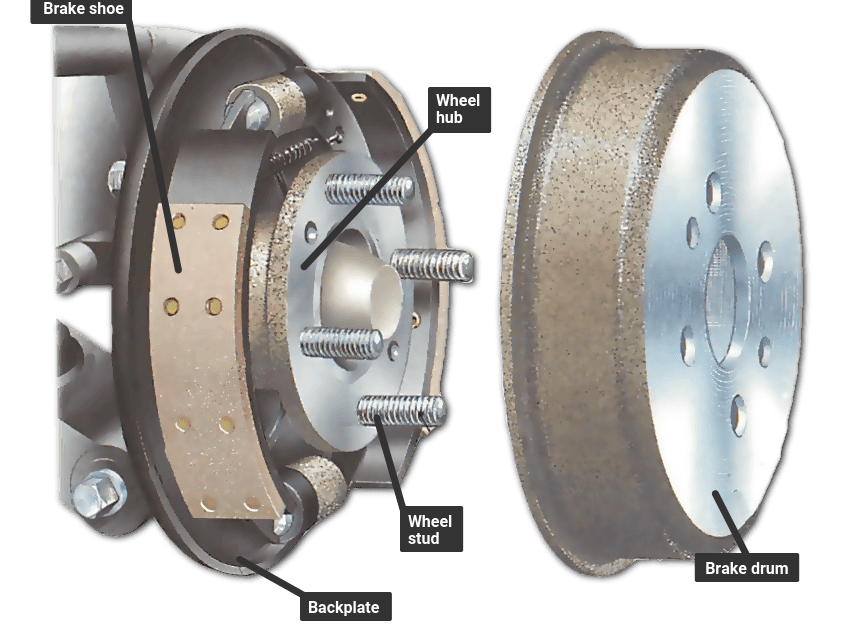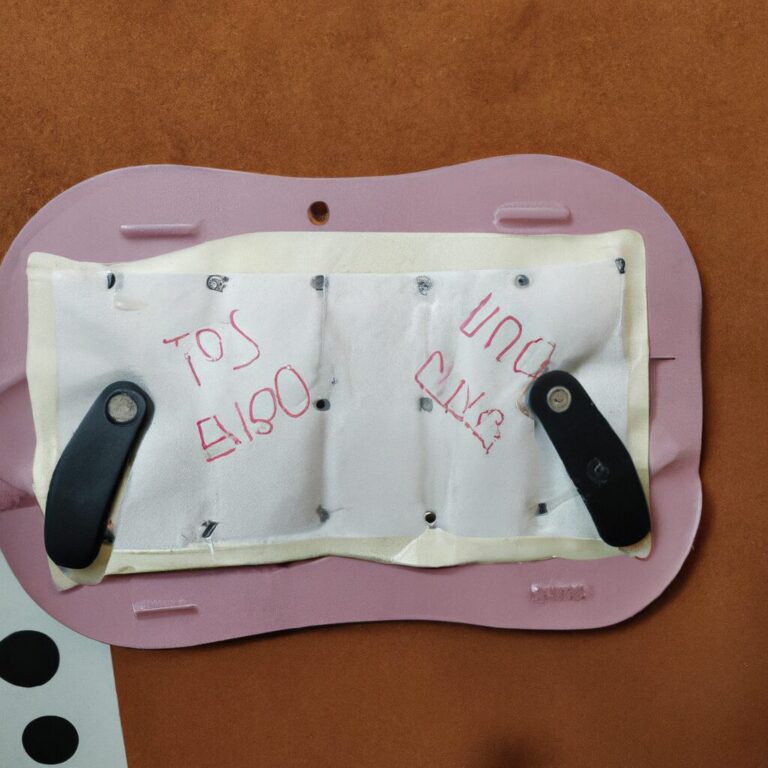When to Replace Drum Brake Shoes
Drum brake shoes should be replaced when they are worn down to the minimum thickness specified by the manufacturer. Drum brake shoes play a vital role in the braking system of a vehicle by providing the necessary friction to slow down or stop the vehicle.
Over time, due to repeated use, the brake shoes wear out and eventually need to be replaced. It is essential to monitor the wear of the brake shoes regularly and replace them promptly when they reach the minimum thickness to ensure optimal braking performance and safety on the road.
We will discuss the indicators that it’s time to replace drum brake shoes and the importance of timely replacement for vehicle maintenance and safety.

Credit: www.youtube.com
Signs Of Worn Drum Brake Shoes
Reduced Braking Performance
If you notice reduced braking performance, such as the need to press harder on the brake pedal for the same stopping power or a longer stopping distance, it could indicate that the drum brake shoes are worn out and need replacement.
Strange Noises
Strange noises like squealing, grinding, or clicking when applying the brakes could be a sign of worn drum brake shoes. These noises could indicate that the shoes have reached the minimum thickness and are causing metal to metal contact, which can lead to reduced braking efficiency and potential brake failure.
Visible Wear
Inspecting the drum brake shoes for visible wear, such as uneven or excessive wear, cracks, or deep grooves, is crucial. These signs can indicate that the shoes have worn past the recommended thickness and need to be replaced to ensure optimal braking safety.
Determining The Replacement Interval
Determining the replacement interval for drum brake shoes depends on several factors, including the wear and tear of the shoes, the vehicle’s mileage, and the manufacturer’s recommendations. Regular inspection and maintenance can help identify when it’s time to replace them.
Manufacturer Recommendations
Consult your vehicle’s manual for the optimal replacement interval.
Mileage Considerations
Replace drum brake shoes every 50,000 miles for optimal performance.
Visual Inspection
- Check for signs of wear regularly to ensure safe braking.
- Replace brake shoes if lining thickness is less than 1/8 inch.
Replacing Drum Brake Shoes
In order to ensure optimal braking performance and safety, it is essential to replace worn-out drum brake shoes in a timely manner. Here is a simple guide to walk you through the process of replacing drum brake shoes step by step.
Gathering Necessary Tools And Materials:
- Jack
- Jack stands
- Wheel lug wrench
- Flathead screwdriver
- Brake lubricant
- Replacement drum brake shoes
Lifting And Securing The Vehicle:
- Loosen the lug nuts
- Jack up the vehicle
- Secure the vehicle with jack stands
Removing The Wheel And Drum:
- Remove the lug nuts
- Take off the wheel
- Remove the brake drum
Replacing The Old Shoes:
- Remove the springs and pins holding the old shoes in place
- Take out the old shoes and replace them with the new ones
- Secure the new shoes with springs and pins
Reassembling And Testing:
- Reinstall the brake drum
- Put the wheel back on
- Lower the vehicle and remove the jack stands
- Test the brakes to ensure they are functioning properly

Credit: www.howacarworks.com
Common Mistakes To Avoid
When it comes to replacing drum brake shoes, there are common mistakes that many people make which can affect the performance and safety of the braking system. By avoiding these errors, you can ensure that your brake shoes are installed correctly and function as they should.
Not Following Proper Safety Precautions
Many people overlook the importance of safety precautions when replacing drum brake shoes. It is crucial to wear protective gear such as gloves and safety glasses to prevent injury from sharp edges and brake dust. Failure to take these precautions can result in accidents and injuries. Being mindful of safety measures is crucial to avoid unnecessary risks.
Incorrect Installation Of New Shoes
One common mistake is the improper installation of new brake shoes, which can lead to reduced braking efficiency and premature wear. It is essential to follow the manufacturer’s guidelines and ensure that the brake shoes are assembled correctly. Incorrect installation can compromise the braking system’s performance and compromise safety on the road.
Neglecting To Adjust The Brakes
Another mistake is neglecting to adjust the brakes after installing new brake shoes. Failure to adjust the brakes can lead to uneven braking, excessive wear, and diminished stopping power. It is essential to perform the necessary adjustments to maintain the proper function of the drum brakes and ensure consistent and reliable braking performance.
Benefits Of Timely Replacement
Timely replacement of drum brake shoes is crucial for maintaining a safe and efficient braking system. Old and worn-out brake shoes can lead to reduced braking performance and safety risks. Replacing them when needed ensures proper vehicle control and prevents potential accidents.
Ensuring Optimal Braking Performance
Replacing drum brake shoes in a timely manner guarantees optimal braking performance for your vehicle. By keeping the brake shoes in top condition, you can ensure consistent and efficient stopping power whenever you need it. Over time, brake shoes can become worn or damaged, resulting in a decrease in braking performance. This can lead to longer stopping distances and increased risks on the road.
Preventing Damage To Other Brake Components
Timely replacement of drum brake shoes also prevents potential damage to other brake components. As the brake shoes wear down, the metal backing can come into contact with the drum, causing excessive heat and wear. This can lead to damage to other key brake components such as the drum itself, wheel cylinders, and brake springs. By replacing the brake shoes before such damage occurs, you can save yourself from costly repairs down the line.
Enhancing Overall Safety
Replacing drum brake shoes at the appropriate time enhances the overall safety of your vehicle. When the brake shoes are worn, they may not provide sufficient friction against the drum, resulting in reduced stopping power and longer braking distances. This can be especially dangerous in emergency situations where you need to stop quickly. Additionally, worn brake shoes may also lead to uneven braking, causing the vehicle to pull to one side during braking. By promptly replacing the brake shoes, you can ensure optimal safety for yourself, your passengers, and other road users.

Credit: m.youtube.com
Frequently Asked Questions Of When To Replace Drum Brake Shoes
How Do You Know If Drum Brake Shoes Are Worn Out?
Inspect wear indicators, measure thickness; if less than 1/4 inch, replace. Screeching noise while braking or decreased brake effectiveness indicates wear.
How Do I Know If My Drum Brakes Need Replacing?
Check for warning signs like squeaking, grinding, or pulsating brakes. Inspect brake pads for wear. Listen for unusual noises. If unsure, consult a professional mechanic for evaluation.
What Is The Minimum Thickness For Drum Brake Shoes?
The minimum thickness for drum brake shoes is typically around 1/8 inch or 3 millimeters. It’s crucial to regularly check and replace worn brake shoes for optimal safety and performance.
How Do I Know If My Drum Brakes Are Bad?
To determine if your drum brakes are bad, watch out for warning signs such as squealing or grinding noises, a pulsating brake pedal, reduced braking power, or a burning smell. If you notice any of these symptoms, it is advisable to get your brake system inspected and serviced by a professional mechanic.
Faq 1: How Do I Know If My Drum Brake Shoes Need Replacing?
Inspect your drum brake shoes for visible wear and tear, excessive noise, or a decrease in braking performance.
Conclusion
It is crucial to understand the signs that indicate the need for replacing drum brake shoes. Ignoring wear and tear can lead to safety hazards and damage to the entire braking system. Regular inspection and timely replacement are essential for optimal vehicle performance and passenger safety.
Stay vigilant and proactive about maintaining your drum brake shoes.


